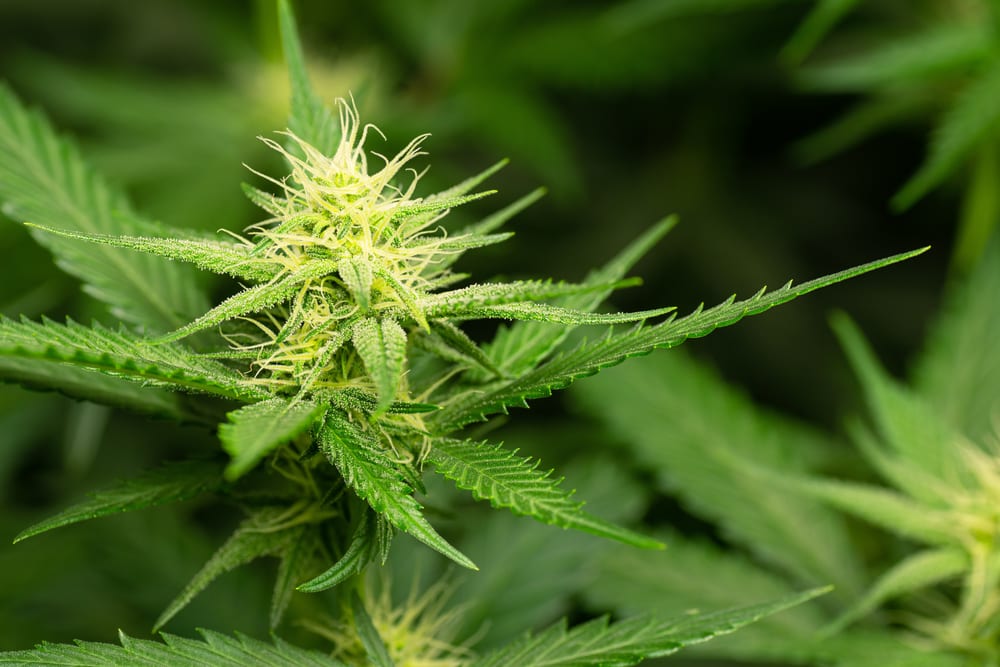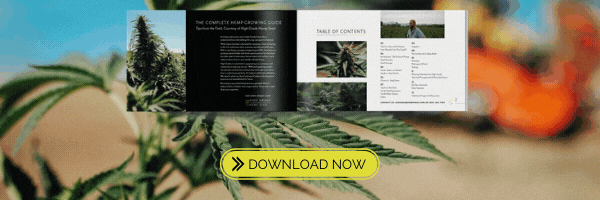There are several factors to consider when choosing the best hemp flower strains for your farm. To begin, you should assess whether your target market is in hemp biomass or boutique flowers. After that, we recommend you take a look at the outdoor growing season at your chosen locale. Once you have chosen hemp strains that meet the demands of your cultivation environment, you can focus on important factors such as cannabinoids, THC compliance, and terpene profiles.
Commercial hemp cultivation is a complex process that requires careful consideration of many factors. However, if you pay keen attention to the details and make educated choices, you’re sure to yield a great harvest. For added benefit, appropriate planning when choosing types of hemp flower can protect your operation’s bottom line.
A Quick Look at Hemp Flower vs. Hemp Biomass
You probably know that hemp is an incredibly versatile crop that can be used for thousands of different purposes. Farmers looking to grow hemp will first need to choose what, in particular, they want to harvest. Hemp can be grown for fiber, seeds, or resin (from which CBD or CBG can be extracted).
 Growing hemp for CBD or CBG can offer a high ROI. Farmers who want to operate large, industrial hemp farms typically choose to harvest hemp biomass. This biomass includes the hemp flower, stalk, and leaves, which are processed and refined together to extract CBD- or CBG-rich resin.
Growing hemp for CBD or CBG can offer a high ROI. Farmers who want to operate large, industrial hemp farms typically choose to harvest hemp biomass. This biomass includes the hemp flower, stalk, and leaves, which are processed and refined together to extract CBD- or CBG-rich resin.
The percentage of CBD or CBG your hemp flowers and/or biomass produces will have a large impact on your ROI, but so will the overall amount of flower your hemp crop produces. If you are looking to sell smokable, boutique-quality hemp flowers, for instance, you want a plant that produces a large number of flowers, as opposed to a plant that is known to have many leaves, which could increase the overall biomass percentage. This is another factor to consider as you compare hemp strains and decide which to grow.
Smaller farmers often choose to harvest hemp flower, which is the bud the hemp plant produces. (Hemp flowers and hemp buds are interchangeable terms.) Hemp flowers can be harvested, cured, and sold as a complete flower. Many customers smoke or vape cured hemp flowers in order to enjoy the relaxing effects of CBD or CBG. Alternatively, processors may purchase dried hemp flowers in order to extract CBD or CBG. Hemp flowers provide a higher percentage of CBD or CBG than hemp biomass.
Types of Hemp Flower & the Growing Season
Different hemp flower strains possess characteristics that may be more or less conducive to your farm and growing season. One of the most important attributes of a hemp strain is its maturation cycle. Farmers who live in areas of the country with a short growing season may do better with hemp plants that mature quickly.
Outdoor hemp farmers in colder regions of the United States must pay particularly close attention to strain selection. That being said, if you plan on cultivating in the Midwest or Northeast, we recommend selecting hemp flower strains that finish well before the autumn freezes arrive. If this is the case, High Grade Hemp Seeds recommends you choose an early finish variety or an autoflower strain. Our Autoflower strain, for example, can be ready for harvest in around 75 days after planting.
Fast-growing hemp strains could also be an ideal choice for farmers with a long growing window and who want to get in a second harvest for the year. In fact, farmers with the benefit of a long growing season can experiment with different types of hemp flower strains. For example, our Red Bordeaux is an ideal choice for farmers interested in staggering their harvests.
Robustness
One of the most important factors in hemp strain selection is the overall robustness of the genetics. If your hemp farm operates without the protection of a greenhouse, your crop must be able to withstand several environmental stressors. Depending on where you are located, most outdoor hemp crops are exposed to excessive heat, heavy rain, strong wind, and cold nights.
Outdoor hemp crops are also under constant attack from bugs and pathogens. Especially during flower season, be sure to choose a hemp strain that is not easily susceptible to botrytis (“bud rot”). Unfortunately, it’s often the plants with the densest flowers that fall victim to this awful mold.
Certain hemp strains are more robust than others and can better withstand weather, bugs, and pathogens. Our Berry Blossom strain, for example, is well known for its toughness. When choosing your hemp flower seeds, take a look at their history and how well they’ve held up for other farmers who have used them.
Which Cannabinoid is Best in Hemp Flowers: CBD or CBG?
The hemp industry continues to evolve with consumer demand. Today, the little-known cannabinoid CBG is beginning to gain the attention of the masses. Historically, growing hemp for CBG has been very difficult, because hemp flowers simply don’t produce high levels of CBG.
CBG starts out in the hemp plant as CBGA (cannabigerolic acid). CBGA can then be broken down into a variety of different chemical compounds, which then break down into CBD and THC. This doesn’t leave much CBGA left over to convert into CBG, which is why normal hemp plants can have as little as 1% CBG. That is changing, as new hemp strains, including our Matterhorn CBG, have been selectively bred to produce high levels of CBG.
When you search for hemp seed strains, first decide if you might want to stick with growing hemp for CBD or experiment with CBG hemp. If you want to give CBG a try, then look for CBG strains. No matter which cannabinoid you want to harvest, make sure you choose hemp flower strains that can deliver a high percentage of either CBD or CBG. The more CBD or CBG your hemp flowers produce, the greater return you’ll get on your crop. Our Matterhorn CBG flower can typically produce 15% CBG.
THC Compliance & Hemp Flower Strains
As important as it is to choose hemp flower strains that can produce high levels of CBD or CBG, it’s equally important to ensure that your hemp buds stay in compliance with the law. The 2018 Farm Bill mandated that all industrial hemp plants must stay below 0.3% THC. Going above this level is known as “going hot.” Research from Cornell University determined that seed genetics play a large role in how quickly THC content increases as a hemp plant reaches maturity. When searching for the best hemp buds, check the strain’s history of THC compliance. If your hemp plants run hot before you can harvest them, you will lose your entire crop! This is why choosing the best genetics is an essential part of a successful hemp growing season.
Hemp Flower Strains & Terpene Profile
One of the biggest distinguishing factors between hemp strains is their terpene profile. A hemp flower’s “terp profile” refers to its aromatic qualities. A hemp plant’s terp profile is a huge selling point, as hemp bud smokers will often seek out their favorite flavors.
Hemp plants produce terpenes, which are found in trichomes (tiny hair-like structures around the buds, stems, and stalks of the hemp plant). Hemp plants use terpenes to ward off enemy insects while inviting helpful pollinators. Scientists have discovered over 100 unique terpenes, and fascinating research suggests that terpenes, along with other, lesser-known cannabinoids, may create an “entourage effect” that enhances the effects of CBD or CBG.
When reviewing different hemp flower strains, pay attention to the terpene profiles. Some hemp flowers, for example, offer fruity or floral notes. Others are famous for heavy flavors of skunk, cheese, and even gasoline. Certain customers absolutely love the biggest, boldest skunky hemp flowers.
Here’s a quick list of all the different terp profiles our hemp strains offer:
- Berry Blossom: Extremely floral; smothered in exotic overtones of candied raspberries and acai berries.
- Red Bordeaux: Strong overtones of fresh-cut strawberries and crushed lavender with hints of cherry and gasoline.
- Merlot: A sharp and robust frame of freshly opened tennis balls and orange peel underscored with rich tones of chocolate and cherries jubilee.
- Autoflower: Sweet and spicy.
- Cherry Wine: Complex cherry floral frame with pine skunk undertones.
- Trophy Wife: Heavy notes of cheese and skunk complemented by cherry undertones.
- Matterhorn CBG: Effervescent notes of citrus, lemon, and lime.
- Chardonnay: Strawberry rhubarb jam and candied raspberries.
How Do You Find the Best Hemp Flower?
As you may have already inferred, commercial hemp cultivation is a complex affair that requires the careful consideration of many factors. While the process of strain selection may seem daunting, it is extremely important. By taking the right steps before you plant your crop, you set yourself up for success when harvest time finally arrives.
When selecting the best hemp strains for your farm, you must consider whether you want to grow boutique flowers or biomass. With this information in hand, you should assess the growing season in your locale to choose the best strain for the job. Finally, you can narrow down your strain selection with the all-important considerations of cannabinoids and terpenes.
How can you balance all these different features to find just the right hemp strain that will thrive on your farm and give you the highest ROI? A great option is to start by looking for the best hemp flower company and reaching out to their customer representatives. A knowledgeable representative will learn more about your goals, your budget, and your farm and then be able to make recommendations.
Once you have a hemp strain in mind, the next step is to test it out. It’s a good idea to start small for your first hemp harvest. You may even want to plant just a single acre so you can see how the hemp takes to your soil, what your labor needs are, and what the harvesting process is like. If the plant thrives and gives you a good return, it’s time to plant more next year. (Start by reading our 2021 Hemp Growing Guide.)
Have more questions about the best hemp flower online? Contact us today. We’ve been in the hemp genetics and seed business for almost ten years and have worked with leading farmers and researchers to develop our hemp flower strains. Our strains are widely respected and considered foundational in the hemp industry. Just as importantly, our seeds are also planted throughout the country. We can’t wait to hear from you!

